2015 is the International Year of Light declared by the United Nations. In Agora Keynote Session 5, scholars who have been doing critical research on light and an artist using light were on stage, and they introduced the audience the world of light from various perspectives.
セッションの初めにJST副理事の渡辺美代子氏があいさつ。東日本大震災をきっかけに、日本でも、科学者だけでなく国民も一緒に科学の未来を考え、作っていく必要があるという認識が生まれたことに触れたうえ、このセッションでは「研究科学の話だけでなく、光がどう世の中に役立っているか、アートや音楽まで、幅広い講演がある」と紹介しました。
Miyoko Watanabe, Deputy Executive Director of JST, gave the opening words at the beginning of the session. She mentioned the following: Since the Great East Japan Earthquake, Japan began to realize that it is necessary to think about and create the future of science not solely by scientists but together with the general public. There will be a wide variety of presentations in this session, from scientific research to the role of light in the world of art and music.
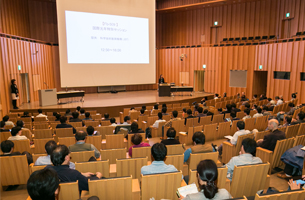
最初の講演者である東京大学教授の荒川泰彦氏は、国際光学委員会(ICO)会長であり、33年前に量子ドットとそのレーザー応用を提案するとともに、量子ドットレーザーの実用化に貢献してきた研究者です。今回は「光の時代〜国際光年によせて〜」と題し、国際光年と光に関する研究の歴史について話しました。
The first presenter Yasuhiko Arakawa is a professor at the University of Tokyo and the ICO president who proposed the concept of quantum dot and its application to semiconductor lasers 33 years ago, contributing to the commercialization of quantum dot lasers. In his presentation titled “The Era of Light ~Towards the International Year of Light~”, he talked about the International Year of Light and the history of research on the light.
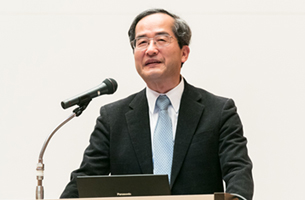
荒川泰彦 東京大学教授・ICO会長
「国際年」とは、国際連合が特定の事情に対して重点的問題解決を全世界の団体・個人に呼びかけるための期間のことで、2015年は光および光技術の国際年と定められています。2015年が国際光年に制定されたのは、「光にかかわる重要な研究成果が、今年から遡って節目となる年に出ているからだ」と荒川氏は解説しました。
The “International Year” is a period designated by the United Nations to advocate selected issues to groups and individuals worldwide to prioritize and come up with solutions, and 2015 was declared as the International Year of Light and Light-based Technologies. Prof. Arakawa explained that 2015 was declared the International Year of Light “because 2015 marks an important milestone when important research achievements on light were presented.”
まず、今からちょうど1000年前に、「近代光学の父」と呼ばれるイブン・アル=ハイサムが、幾何光学の三法則(直進、反射、屈折)など、現代の幾何光学の基本的な考え方に言及した『Kitab al-Manazir』(光学の書または視覚の書)を書きました。また、フレネルレンズの発明者でもあるオーギュスタン・ジャン・フレネルが光は横波であることを発見したのが200年前、アルベルト・アインシュタインの一般相対性理論が100年前、そしてビッグバンの兆候である宇宙マイクロ波背景放射が発見され、光ファイバーが作られたのが50年前ということです。
First, Ibn al-Haitham, the Father of Modern Optics, wrote the “Kitab al-Manazir” (Book of Optics or Books of Visions) 1000 years ago which mentioned most of the basic ideas on optics such as the three laws of geometrical optics (direction, reflection, and refraction). Then, Augustin-Jean Fresnel, who invented the Fresnel lens, discovered that light was a transverse wave 200 years ago, followed by Albert Einstein, who proposed the general theory of relativity 100 years ago. In addition, the cosmic microwave background radiation as a sign of the Big Bang was discovered, and optical fibers were invested 50 years ago.
講演ではさらに、光に関わるノーベル賞の歴史や、荒川氏の専門であるレーザーの技術が57年前からどのように進歩したかについても触れました。
Prof. Arakawa also talked about the history of Nobel Prizes related to light and how laser technology has evolved in the last 57 years.
光学・赤外線天文学が専門の国立天文台教授 臼田知史氏は、「宇宙からの光〜すばる望遠鏡と超大型望遠鏡TMT〜」と題して、「ひかり」で宇宙を探る技術について語りました。宇宙の研究においては、「技術革新があって、新しいものが見えるようになる、それが宇宙像を変える、そしてさらなる技術革新が必要になる、というサイクルが重要だ」との見方を示しました。
Tomonori Usuda, a professor at the National Astronomical Observatory of Japan specializing in optics and infrared astronomy, spoke about exploring the universe with technology using “light” in his presentation “Light from the Universe ~ Subaru Telescope and the Extremely Large Telescope TMT”. He explained the importance of a cycle in which technological innovation leads to new discoveries and changes in how we see the universe, which then leads to the further need for technological innovation.
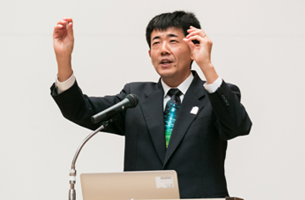
近年は望遠鏡が大型化。1999年に作られたすばる望遠鏡は8.2mの単一鏡を持っていますが、2024年完成予定のTMTには30mのセグメント鏡が搭載されます。これは、144cmの鏡を492枚敷き詰めるもので、すばる望遠鏡に比べて、13倍の集光力、4倍の解像力を持ちます。
In recent years, telescopes have increased in size. The Subaru Telescope made in 1999 utilizes a single 8.2-meter mirror, but the TMT anticipated to be completed in 2024 will be equipped with a 30-meter segmented mirror. It will consist of 492 mirror segments at 1.44-meters each and harness 13-times more light-gathering power and 4-times more resolving power than the Subaru Telescope.
すばる望遠鏡では、新たにHyper Suprime-Cam(HSC)という9億画素のデジタルカメラが完成しました。これは、アンドロメダ銀河の全体を写せる上に、その中の星を一つ一つ分解して観測することができます。また、波面補償光学(Adaptive Optics: AO)という、大気擾乱をリアルタイムに補正する技術も進んでおり、これによって、「地上望遠鏡でも宇宙望遠鏡を凌ぐ視力を達成することができるようになる」と言います。
A 900 million-pixel digital camera called the Hyper Supreme-Cam (HSC) developed for the Subaru Telescope can capture not only the entire Andromeda galaxy, but it further enables individual stars to be resolved and examined. Furthermore, advancement in the Adaptive Optics (AO) technology to perform the real-time correction of atmospheric disturbances is anticipated to “allow ground-based telescopes to harness vision that exceeds those of the space telescopes.”
これらの技術を集約したTMTでは、すばる望遠鏡でははっきり見ることができなかった129億年前の銀河における星形成の様子を明らかにすることを目指します。また、高精度の分光技術によって、「太陽系外にある惑星の大気に、酸素や水、有機物などを検出し、地球に限りなく似た惑星を探すことで、生命の痕跡を見つけることができるのではないか」と期待しているそうです。
With all of these technologies squeezed into the TMT, it aims to see the initial creation of galaxy and stars in the universe from 12.9 billion years ago, which could not be clearly observed with the Subaru Telescope. Also through high precision spectroscopic technology, he hopes to “find traces of life by searching for planets as much similar to Earth as possible by detecting oxygen, water, organic matter, etc. in the atmosphere of Extrasolar planets.”
一方、光格子時計を作った東京大学教授の香取秀俊氏は、「光で時空を測る―原子時計で時間の18桁目を読む―」と題して講演しました。現在、国際原子時はセシウム原子時計によって定められています。これは3000万年に1秒ずれるため、約1×10の-15乗、つまり15桁目まで分かる時計ということになります。それに対し、光格子時計は「宇宙の年齢138億年の2倍経っても1秒しか狂わない」という、18桁が読める時計です。この時計によって、「10年後には秒が再定義される可能性がある」と香取氏は言います。
On the other hand, Professor Hidetoshi Katori of the University of Tokyo who invented the optical lattice clock spoke on the subject of “Measuring Space-Time with Light - Reading the 18th Place of Time in an Atomic Clock -.” Today, the International Atomic Time is realized by a cesium atomic clock. It becomes 1 second off in 30 million years, so it is a clock that is accurate to approximately 1 x 10^-15 or 15th place. In contrast, the optical lattice clocks gain or lose 1 second in twice the age of the universe which is 13.8 billion years, reading the 18th place. Prof. Katori explained that this clock may be used to redefine one second in the next 10 years.
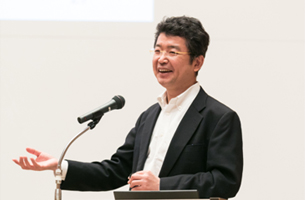
このように高精度な時計を求める理由はいくつかあります。例えば、物理定数は本当に定数なのか、という研究につながります。現在、ダークマターと原子時計の相互作用は分かっていないため、太陽系がダークマターのあるところを通るとき、原子時計の時間が変わっているかもしれないというのです。
There are several reasons why we seek high-precision clocks. For example, it leads to the research of whether the physical constant is actually a constant. Currently, the interaction between dark matter and the atomic clock is not known, so there is a possibility that the time of an atomic clock changes when the Solar System passes through dark matter.
さらに香取氏は、より高精度な時計ができると、「時計が量子・高度差計になり、いずれ水準点を置き換えるようになるかもしれない」とも話しました。18桁が分かる時計では、時計の位置が1cm高くなっただけでも時間が速く進んでいるということが分かるのです。
Also, Prof. Katori talked that “with a high-precision clock, the clock would become a quantum altimeter and may replace the benchmark in the future. A clock that reads time at the 18th decimal place would recognize that the time is passing by faster even if it were to be lifted up by a mere centimeter.
「これまでは宇宙的規模でないと、一般相対理論の効果は分からなかった。しかし、光格子時計によって、重力で時空間が曲がっているということが、身近なスケールで分かるようになってきたと言える」と解説しました。
He explained “until now, the effects of general relativity were only recognized at the level of the universe. However, with the optical lattice clock, we have come to realize the deformation of the space time caused by gravity in our daily life.
アーティストであり、主にデジタル映像を扱う株式会社ネイキッドの代表である村松亮太郎氏の講演「光を操る」は、氏が手掛けたさまざまな光のアートの動画から始まりました。中でも有名なのは東京駅のプロジェクションマッピングですが、それらのアートのポイントは、「人間の目が、どのように光を認識しているか」を利用することだと言います。われわれは光を認識して「見て」いますが、光源があることを意識しません。その隙を突くことで、錯覚を起こさせるというのです。
The presentation “Manipulating Light” by artist Ryotaro Muramatsu, who is also the president of NAKED Inc. handling mainly digital images, began with a video of art using light. A famous example was the projection mapping at Tokyo Station, and he explained that the key in such art is to utilize the mechanism of “how human eyes recognize light.” We recognize light and “see”, but we are not conscious of the light source. An optical illusion is created by focusing on that gap.
例えば同社は、錯視によって静止画が動いているように見せる「変幻燈」というNTTの研究所が開発した技術を用いて新しい映像表現に取り組んでいます。色をいじるのではなく、輝度を変化させているだけですが、「人間は明るさの情報に敏感に反応するため、絵が動いているように見える」と言います。
For example, the company is working on a new way of expression through picture using a technique that the NTT research institute called “Deformation Lamps”, to show the illusion that still images appear to be moving. Only the brightness is changed, and the color is not touched, but “the image can be seen as if it is moving because people are sensitive to brightness.”
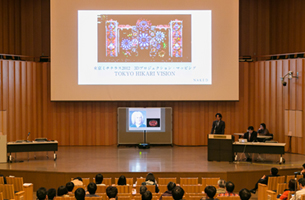
また、「光が、どのように透過し、そして反射するか」という光の特性を活かしたアートも手掛けました。ある方向からの光は通過し、ある方向からの光は通過せずに反射するというナノテクノロジーを駆使した開発中の透明なフィルムを見いだし、展望台のガラス窓にそのフィルムを貼ることで、昼は普通に景色が見え、夜は窓に映像を投影し、夜景と映像の両方を見ることができるようになりました。
Moreover, the company handles art utilizing the characteristic of light like how it permeates and reflects. They are currently projecting the invention of a clear film that has the technology to permeate light from one angle and reflect it to another. By placing the film on the windows of an observatory, the scenery could be seen as usual during the day, but at night an image is projected and both the night view and the image could be seen.
村松氏は表現者として光には思い入れがある、と述べます。「光がないと真っ暗で、表現どころの話ではない。光があるから、色があって、美しいと感じることができる。そして色という認識があるからこそ、世界中の文化がある。表現者にとって光はもっとも重要なものではないかと思う」と語り掛けました。
Mr. Muramatsu said that he was attached to light as an artist. He said, “Without light it is pitch black, and there wouldn’t be the capability of expression to start with. Because there is light, there are colors, and we can feel that things are beautiful. And because there is recognition of colors, there are cultures around the world. Light is probably the most important thing to an artist.”
最後の講演は、面発光レーザーを発明した東京工業大学名誉教授・前学長の伊賀健一氏による「光と音:すばらしき波の世界」。コントラバスの演奏やパソコンでの音楽の再生などを交えながらの和やかな講演でした。
The last presentation was by Kenichi Iga, Professor Emeritus, former president at Tokyo Institute of Technology and the inventor of a surface emitting laser, on the subject of “Light and Sound: the Beautiful World of Waves”. It was a harmonious presentation that included contrabass performance and playing music with a computer.
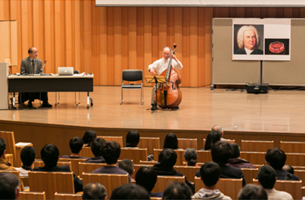
弦の振動をゴム紐で実演する場面もあり、弦の振動は横波であることが眼で確認 できました。一方,「音波は空気の粗密による縦波であるため、弦の振動と垂 直方向には音は出ない。ところが、コン トラバスのような弦楽器では、弦の横 振動が楽器のボディーに伝えられてボディー各部の板が縦振動する。そこから効率 よく縦波である音波が放 射される。」との説明がありました。そして光も音も 波であり、「今は分野として分かれてしまっているが、どちらも波動なので一緒 に勉強す るとよろしい」との若い人への助言がありました。
There was a moment where the vibration of a string was demonstrated by using a rubber band. It was visible that the vibration is a manner of transverse mode. He explained the mechanism of instrument: “Normally the string vibrating with transverse mode cannot radiate longitudinal sound wave to its normal direction. But a loud sound could be created by the longitudinal vibration in the board of instruments such as contrabass. That vibration is effectively driven by the string through the bridge. This is the physics of musical instruments.” He recommended the young participants to study the light and sound together as they both involve wave motions although they are currently studied separately.
続いて、氏の専門であるレーザーについてのお話がありました。半導体レーザーでは、電子とホール(エネルギーの低い軌道にできた電子の抜けた穴)が同じ空間に入ると、波動関数が干渉して光が出ます。同じ仕組みのLEDは自然放出光が広がるのに対し、レーザーは反射鏡を置くことで、光が干渉して一つの波長でビーム状になります。
He also talked about the field of lasers, which he specializes in. With a semiconductor laser, when the electron and the hole enter the same space, they interfere and create light. In contrast to the LED with the same mechanism that spreads spontaneously emitted light, the laser becomes a beam with a pure spectrum because of the interference of reflecting mirrors.
レーザーの研究が盛んになったのは1960年以降のこと。そして、伊賀氏が面発光レーザーのアイデアを思いついたのは1977年の夜中、寝ているときのことだったと言います。そのころレーザーにはいくつかの課題がありましたが、氏が不満を感じたのが、集積回路と同じような手法で出来る単一波長の半導体レーザーが無いことでした。まさに、「不満は発明の母」とのこと。その後、伊賀氏が研究開発した面発光レーザーは、高速LAN,レーザーマウス、レーザープリンタなど、さまざまな分野へ応用されるようになったのです。
Research on light became common after 1960. Prof. Iga said that the idea of surface emitting laser emerged while he was sleeping at night in 1977. He emphasized that “dissatisfaction was a mother of invention.” Amongst all the problems regarding lasers at the time, he was especially frustrated by the lack of semiconductor laser which could be made by the processes similar to that of integrated circuits. Later, the surface emitting laser developed by Prof. Iga was applied to things like laser mouse and laser printers.
登壇者の方々の講演ごとに、来場者との間で質疑応答の時間がありました。参加していた高校生からも専門性の高い質問が出るなど、来場者は非常に熱心な様子。壇上からの返答にも熱がこもり、時間が足りないほどでした。
There was time for questions and answers after every lecturer. The audience, ranging from high school students to specialists was very earnest on questioning the guests. The panelists answered with great passion that there was hardly any time left.
セッションの最後には、JST副理事の伊藤宗太郎氏があいさつし、「世界の第一線、日本を代表する研究者とクリエイターの方々の、光に関するいろいろなお話をうかがいました。光のことについて考える機会になればいいと思います」とセッションを締めくくりました。
At the end of the session, Sotaro Ito, Deputy Executive Director of JST, gave the closing words and closed by commenting, “We heard many presentations about light by researchers and creators leading the world and representing Japan. I hope this inspired you to think about light.”
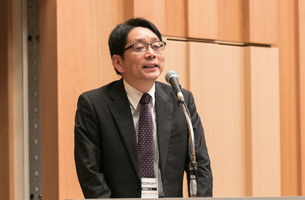
光に関する多様なお話を伺っているうちに、あっという間に3時間が経ってしまいました。梶田隆章先生のノーベル賞受賞はもちろん、国立科学博物館の「ヒカリ展」など、個人的にも光に関連して心沸き立つことの多かった国際光年。このセッションでは、第一人者の方々を身近に感じ、その肉声を耳にすることができて、とても感慨深かったです。また、若い世代から年配層まで、熱心に耳を傾ける方が多かったことも印象に残りました。(谷内悠)
After hearing all the interesting stories and research on light, three hours had gone by in an instance. There were many stories on light that truly intrigued me from the heart, including “The Hikari Exhibition” of the National Science Museum, not to mention the winning Nobel Prize of Mr. Takaaki Kajita. This session was deeply moving as I was able to actually feel and hear from the foremost figures of this topic. It was impressive to see that people from youth to elderly were studiously listening to the panelists. (Yu Yachi)